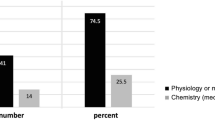Abstract
Nobel Laureates are used as a proxy to study at what age scientists produce their most groundbreaking work. We determine the average age of Nobel Laureates at the time that their Prize-winning research was conducted. This is done using the Advanced Information document with scientific background information published by the Nobel Foundation for every awarded Nobel Prize since 1995 for physics and economics, 2000 for chemistry and 2006 for physiology or medicine. For all Laureates their average age when their Prize-winning research was conducted was \(44.1 \pm 9.7\), with Laureates in physics generally being younger compared to the other fields. It is shown to be statistically significant that Laureates in physics have published their Nobel Prize winning works within a shorter span of years compared to the other fields, whereas Laureates in economics use a longer span of years. The number of papers cited by the Nobel Foundation for each Laureate was found to be \(9.6 \pm 8.6\), with Laureates in physics have significantly fewer papers cited compared to the other fields, \(5.4 \pm 4.8\), while Laureates in economics have significantly more, \(17.3 \pm 11.5\). Finally, we find that Laureates wait an average of \(22.3 \pm 10.8\) years between conducting their prize-winning research and receiving the Nobel Prize.




Similar content being viewed by others
References
Baffes, J., & Vamvakidis, A. (2011). Are you too young for the Nobel Prize? Research Policy, 40, 1345–1353.
Chan, H. F., Gleeson, L., & Torgler, B. (2014). Awards before and after the Nobel Prize: A Matthew effect and/or a ticket to ones own funeral? Research Evaluation, 23, 210.
Chan, H. F., Önder, A. S., & Torgler, B. (2015). Do Nobel Laureates change their patterns of collaboration following prize reception? Scientometrics, 105, 2215.
Chan, H. F., Önder, A. S., & Torgler, B. (2016). The first cut is the deepest: Repeated interactions of coauthorship and academic productivity in Nobel Laureate teams. Scientometrics, 106, 509.
Chan, H. F., & Torgler, B. (2013). Science prizes: Time-lapsed awards for excellence. Nature, 500, 29.
Chan, H. F., & Torgler, B. (2015). The implications of educational and methodological background for the career success of Nobel Laureates: An investigation of major awards. Scientometrics, 102, 847.
Clauset, A., Larremore, D. B., & Sinatra, R. (2017). Data-driven predictions in the science of science. Science, 355, 477–480.
Jones, B. F., & Weinberg, B. A. (2011). Age dynamics in scientific creativity. Proceedings of the National Academy of Sciences, 108, 18910–18914.
Karazija, R., & Momkauskait, A. (2004). The Nobel prize in physics—regularities and tendencies. Scientometrics, 61, 191.
Kragh, H. (1999). Quantum generations: A history of physics in the twentieth century. Princeton: Princeton University Press.
Manniche, E., & Falk, G. (1957). Age and the Nobel prize. Systems Research, 2, 301–307.
Schlagberger, E. M., Bornmann, L., & Bauer, J. (2016). At what institutions did Nobel Laureates do their prizewinning work? An analysis of biographical information on Nobel Laureates from 1994 to 2014. Scientometrics, 109, 723–767.
Sinatra, R., Wang, D., Deville, P., Song, C., & Barabási, A.-L. (2016). Quantifying the evolution of individual scientific impact. Science, 354, aaf5239.
Stephan, P. E., & Levin, S. G. (1993). Age and the Nobel prize revisited. Scientometrics, 28, 387.
The Nobel Prize. https://www.nobelprize.org/nobel_prizes/lists/laureates_ages/all_ages.html. Accessed 5 Dec 2018.
Wagner, C. S., Horlings, E., Whetsell, T. A., Mattsson, P., & Nordqvist, K. (2015). Do Nobel Laureates create prize-winning networks? An analysis of collaborative research in physiology or medicine. PLoS ONE, 10, e0134164.
Way, S. F., Morgan, A. C., Clauset, A., & Larremore, D. B. (2017). The misleading narrative of the canonical faculty productivity trajectory. Proceedings of the National Academy of Sciences, 114, E9216–E9223.
Author information
Authors and Affiliations
Corresponding author
Rights and permissions
About this article
Cite this article
Bjørk, R. The age at which Noble Prize research is conducted. Scientometrics 119, 931–939 (2019). https://doi.org/10.1007/s11192-019-03065-4
Received:
Published:
Issue Date:
DOI: https://doi.org/10.1007/s11192-019-03065-4




